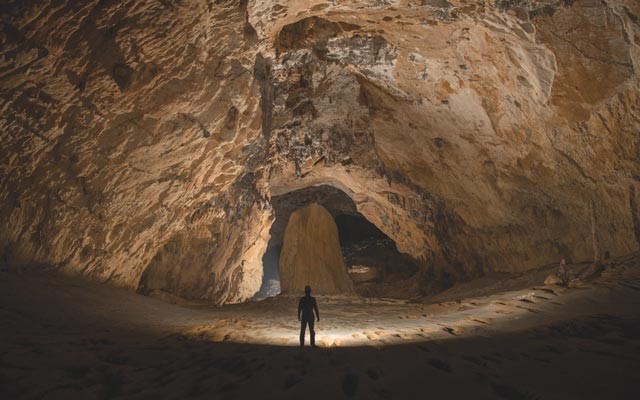We're in this isolated area on Vancouver Island. We start bushwhacking and I hear — Woohoo! Someone had found a huge hole in the mountain and they're all saying 'OK, who's first?' I'm new so I say 'Sure, I don't mind,' and down I go," relates the youthful, dark-haired man seated in front of me. Tall, tanned and rugged, his muscled forearms ripple as he leans forward.
"I'm hanging in space at the end of the rope and I realize: I'm the very first human who's been here... then I get scared that I might trigger a landslide because no one knows what's down here. At the bottom is a huge snow choc — just like in a crevasse. Water dripping from the surface has melted a five-metre tunnel right through it; we have no idea what's below, so of course we just rappel down through the hole."
Francois-Xavier De Ruydts leans back and sips his beer with satisfaction. He knows how crazy it sounds but that's the point: a story that mixes the thrill, fear and abiding discovery offered by caves. The Vancouver-based photographer has dozens of such tales, but this one, from only his second caving expedition, was the one that sucked him down the rabbit hole of underground exploration.
They call him "Fix" and with good reason: his given name is a mouthful. But the moniker has utility for his vocation: In the echo-chamber spaces below the planet's surface, monosyllabic words work best for communication, a fortuitous safety feature in one of the world's most dangerous activities. Fix speaks with the ease of someone who's found their calling. That the 32-year-old takes his time with questions of a philosophical nature suggests there's something else to unearth — an inner journey to parallel the myriad physical paths taken in the four years since quitting a job he didn't enjoy and moving from Belgium to Canada with his wife, Idalina.
Not that he hadn't done anything radical before. An inveterate traveller and outdoorist, as a teenager Fix rock-climbed in Europe and crossed Quebec by canoe. Following university he rode a bike around the world on what he figured would be his last great adventure before settling down. Afterward, however, the travel bug hit worse than ever. As a trained geographer, he'd had no trouble landing environmental work for waste management projects, but within three years he couldn't stand it. When Idalina suggested a move to Vancouver, he had to look it up on a map — but he liked what he saw. In Canada he found work as a mapper, but quit after only six months to become a photographer. He'd flirted with the idea before, but while adventure photography seemed out of the question in Belgium, Vancouver offered a place where he could make the leap — fully encouraged by Idalina. He put ads on Craigslist for models, shot his wife and friends as well, and soon had a decent portfolio.
If Fix was deliberate about jumping into photography, he was even more calculated on how to succeed. He needed a niche that would differentiate him from other local photographers who concentrated on skiing, boarding, biking, climbing, and paddling. "I thought, well, caving... now there's a terrible sport no photographer wants to do. I mean, it's horrible — you have to crawl in mud for hours or days to get a shot. And there's no light when photography is all about light. Perfect!"
He signed on with a Vancouver Island caving group, did some weekend trips, and came away with some astonishing photos. The next thing he knew Canadian Geographic green-lit his proposal for a winter expedition to Castleguard Cave beneath the Columbia Icefield. "I went with some cave divers. It was a full day travelling on the glacier on skis pulling sleds filled with scuba tanks, and when we got to the cave it was blocked with ice. In winter there's normally an air pocket, but there'd been epic high water at some point and it all froze. We had to retreat."
Eventually Canadian Geographic let him shoot a more general piece on caving. When it appeared as a cover story in 2012, Fix was ecstatic: he'd realized a five-year photography goal in only two years.
After publishing numerous articles and photos, Fix was worried he'd saturated the small niche market. Thinking it might be a few years before he could revisit the cave trope, and wary of being pigeonholed, he cast about for other edgy pursuits, settling on canyoneering — big in the Alps but virtually unknown in Canada. His calculus paid off.
"I started pitching a story about a fast-growing 'canyoneering community' that wasn't quite true — there was potential but not much happening. When a national magazine bit on the idea I had to create the community. I managed to get 15 people together in a bar. We formed a group, made a Facebook page, and got started."
At this same time Fix took up filming as well. More kismet ensued: filming waterfalls in West Vancouver he met an ex-canyoneering guide from Switzerland and together, armed with only the most rudimentary beta, they climbed to the top of Monmouth Creek near Squamish and made a first descent of the otherworldly canyon in two days, with Fix filming. The award-winning result, Down the Line (reelhouse.org/fxderuydts/downtheline) launched other collaborations, including an expedition with Global TV to Booming Ice Chasm, a preternatural alpine cave on the B.C.-Alberta border. It was all coming together for Fix — albeit in the bowels of the Earth.
Much like squeezing through a tight cave passage and discovering a larger amphitheatre on the other side, Fix's choices continue to deliver new experiences and opportunity in the subterranean world. "It's interesting how one thing leads to another when you believe in it."
Visit deruydtsphotography.com to see some of Fix’s stunning work, and watch for a full feature and photographic spread in the upcoming Mountain Life Annual 2014."http://deruydtsphotography.com/"




